Innovation in Construction Practice: BIM, Cloud Services, and Sensing Technologies
VerifiedAdded on 2023/06/10
|8
|2196
|131
AI Summary
This article discusses the role of BIM, cloud services, and sensing technologies in promoting sustainability, effective project delivery, and safety in the construction industry. It analyzes how BIM can support the delivery of construction projects in a more sustainable manner, how cloud services can support more effective project delivery, and how sensing technologies can enhance safety and security in construction sites. The article also explores the challenges of implementing BIM technologies and proposes initiatives to overcome them.
Contribute Materials
Your contribution can guide someone’s learning journey. Share your
documents today.
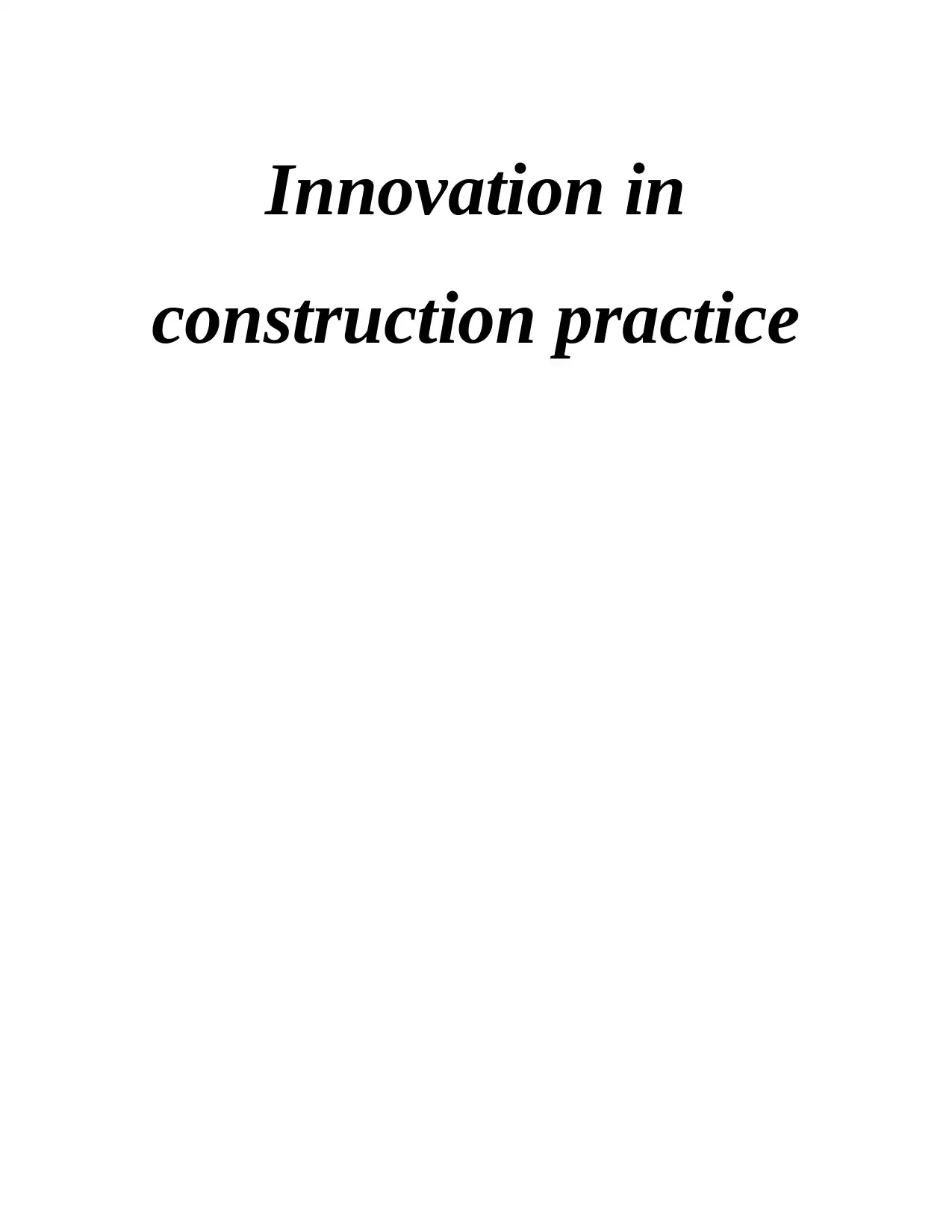
Innovation in
construction practice
construction practice
Secure Best Marks with AI Grader
Need help grading? Try our AI Grader for instant feedback on your assignments.
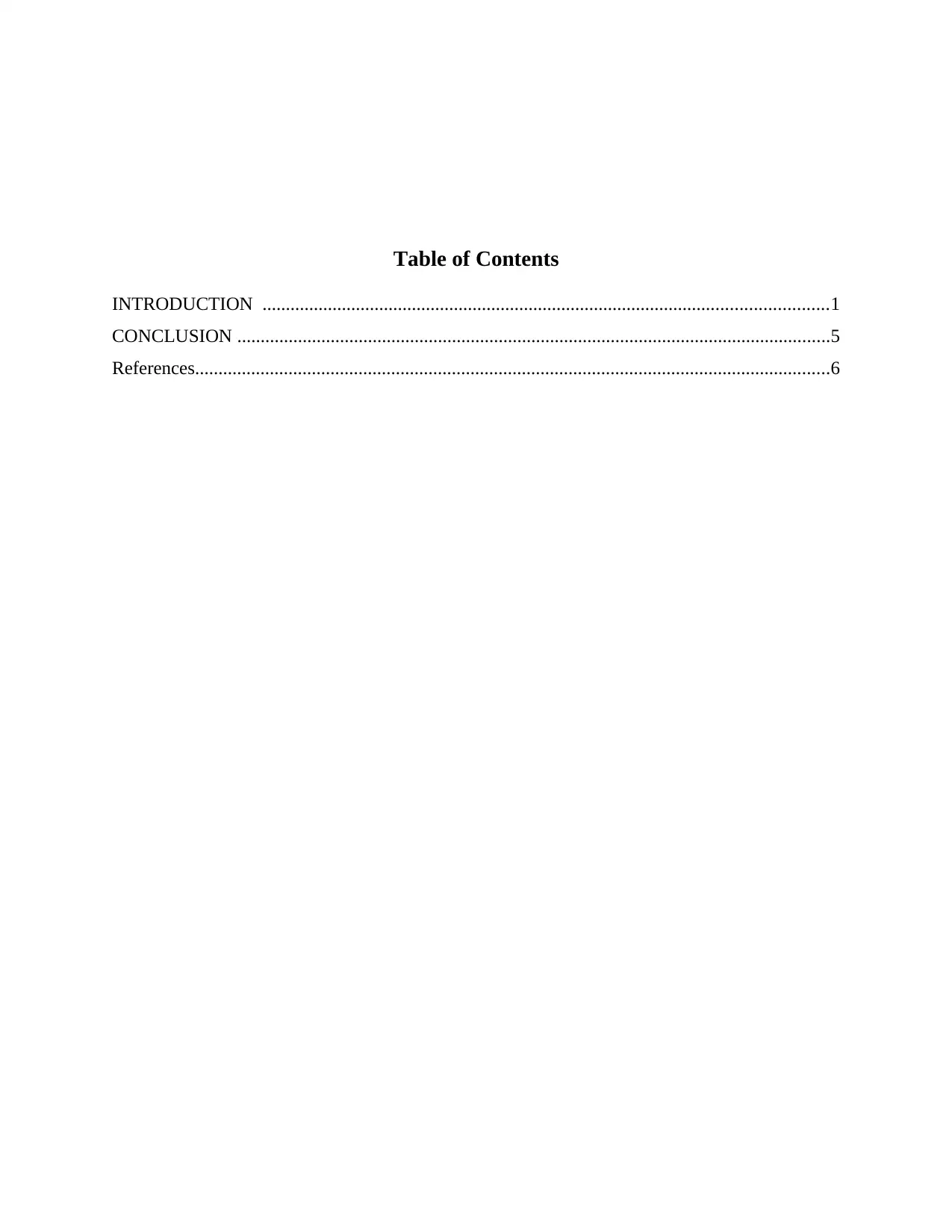
Table of Contents
INTRODUCTION .........................................................................................................................1
CONCLUSION ...............................................................................................................................5
References........................................................................................................................................6
INTRODUCTION .........................................................................................................................1
CONCLUSION ...............................................................................................................................5
References........................................................................................................................................6
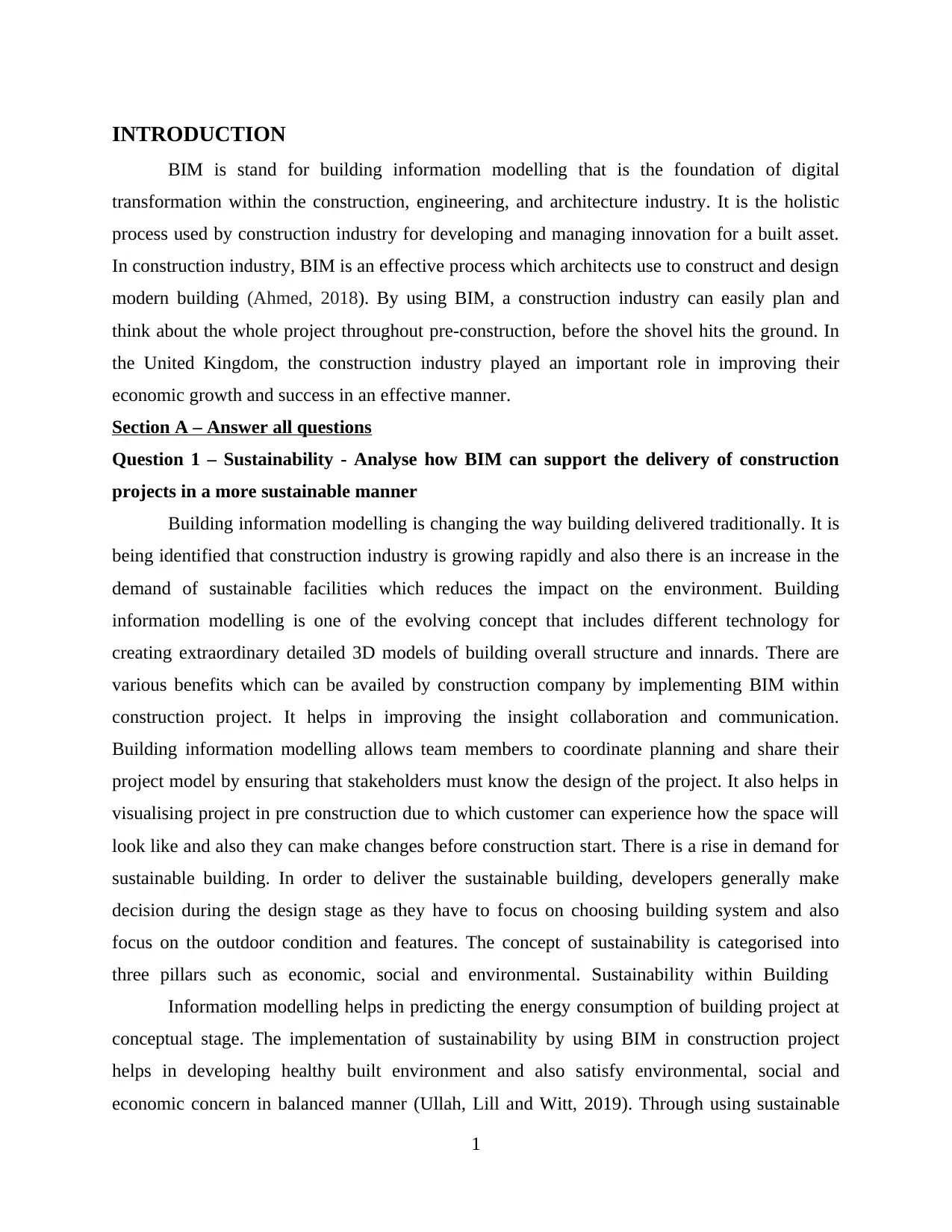
INTRODUCTION
BIM is stand for building information modelling that is the foundation of digital
transformation within the construction, engineering, and architecture industry. It is the holistic
process used by construction industry for developing and managing innovation for a built asset.
In construction industry, BIM is an effective process which architects use to construct and design
modern building (Ahmed, 2018). By using BIM, a construction industry can easily plan and
think about the whole project throughout pre-construction, before the shovel hits the ground. In
the United Kingdom, the construction industry played an important role in improving their
economic growth and success in an effective manner.
Section A – Answer all questions
Question 1 – Sustainability - Analyse how BIM can support the delivery of construction
projects in a more sustainable manner
Building information modelling is changing the way building delivered traditionally. It is
being identified that construction industry is growing rapidly and also there is an increase in the
demand of sustainable facilities which reduces the impact on the environment. Building
information modelling is one of the evolving concept that includes different technology for
creating extraordinary detailed 3D models of building overall structure and innards. There are
various benefits which can be availed by construction company by implementing BIM within
construction project. It helps in improving the insight collaboration and communication.
Building information modelling allows team members to coordinate planning and share their
project model by ensuring that stakeholders must know the design of the project. It also helps in
visualising project in pre construction due to which customer can experience how the space will
look like and also they can make changes before construction start. There is a rise in demand for
sustainable building. In order to deliver the sustainable building, developers generally make
decision during the design stage as they have to focus on choosing building system and also
focus on the outdoor condition and features. The concept of sustainability is categorised into
three pillars such as economic, social and environmental. Sustainability within Building
Information modelling helps in predicting the energy consumption of building project at
conceptual stage. The implementation of sustainability by using BIM in construction project
helps in developing healthy built environment and also satisfy environmental, social and
economic concern in balanced manner (Ullah, Lill and Witt, 2019). Through using sustainable
1
BIM is stand for building information modelling that is the foundation of digital
transformation within the construction, engineering, and architecture industry. It is the holistic
process used by construction industry for developing and managing innovation for a built asset.
In construction industry, BIM is an effective process which architects use to construct and design
modern building (Ahmed, 2018). By using BIM, a construction industry can easily plan and
think about the whole project throughout pre-construction, before the shovel hits the ground. In
the United Kingdom, the construction industry played an important role in improving their
economic growth and success in an effective manner.
Section A – Answer all questions
Question 1 – Sustainability - Analyse how BIM can support the delivery of construction
projects in a more sustainable manner
Building information modelling is changing the way building delivered traditionally. It is
being identified that construction industry is growing rapidly and also there is an increase in the
demand of sustainable facilities which reduces the impact on the environment. Building
information modelling is one of the evolving concept that includes different technology for
creating extraordinary detailed 3D models of building overall structure and innards. There are
various benefits which can be availed by construction company by implementing BIM within
construction project. It helps in improving the insight collaboration and communication.
Building information modelling allows team members to coordinate planning and share their
project model by ensuring that stakeholders must know the design of the project. It also helps in
visualising project in pre construction due to which customer can experience how the space will
look like and also they can make changes before construction start. There is a rise in demand for
sustainable building. In order to deliver the sustainable building, developers generally make
decision during the design stage as they have to focus on choosing building system and also
focus on the outdoor condition and features. The concept of sustainability is categorised into
three pillars such as economic, social and environmental. Sustainability within Building
Information modelling helps in predicting the energy consumption of building project at
conceptual stage. The implementation of sustainability by using BIM in construction project
helps in developing healthy built environment and also satisfy environmental, social and
economic concern in balanced manner (Ullah, Lill and Witt, 2019). Through using sustainable
1
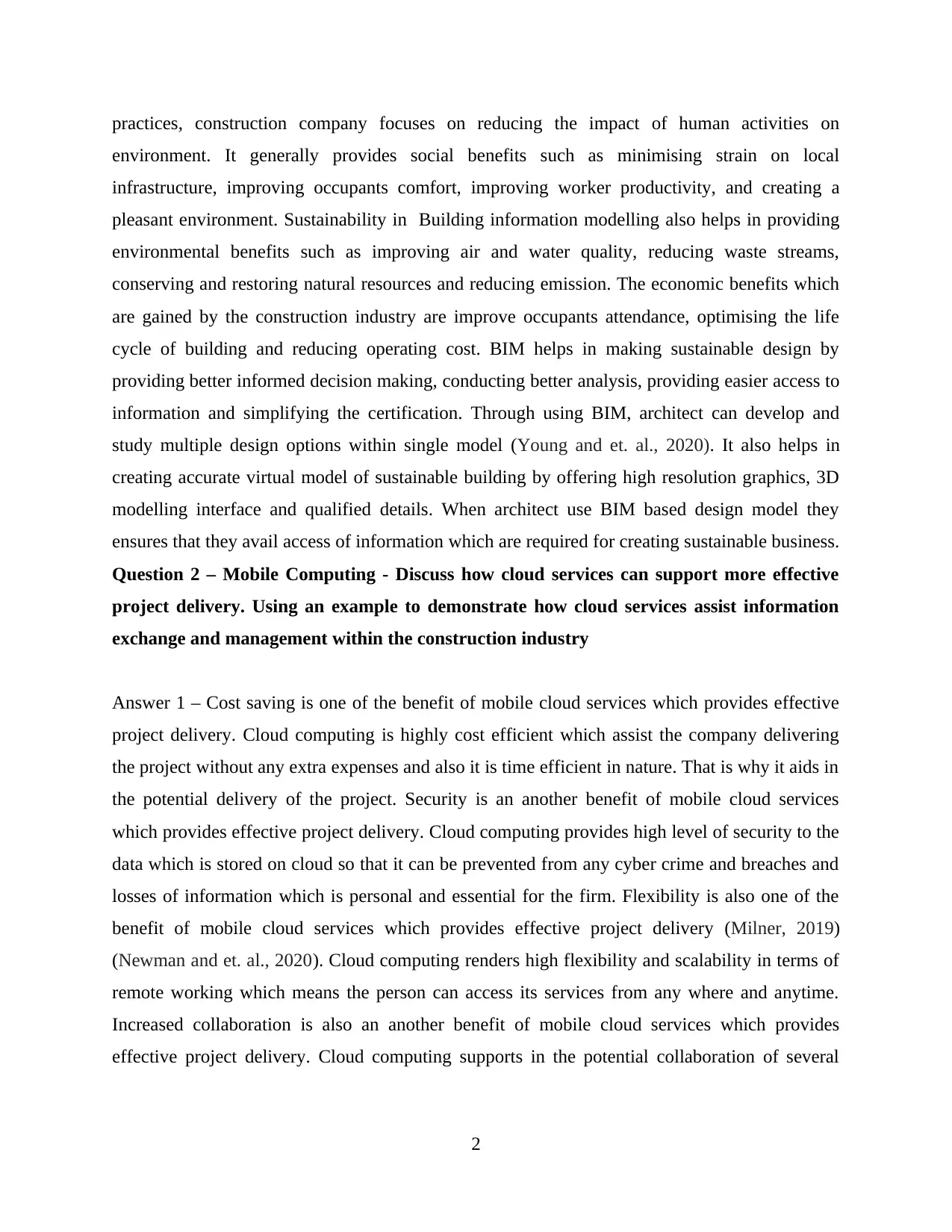
practices, construction company focuses on reducing the impact of human activities on
environment. It generally provides social benefits such as minimising strain on local
infrastructure, improving occupants comfort, improving worker productivity, and creating a
pleasant environment. Sustainability in Building information modelling also helps in providing
environmental benefits such as improving air and water quality, reducing waste streams,
conserving and restoring natural resources and reducing emission. The economic benefits which
are gained by the construction industry are improve occupants attendance, optimising the life
cycle of building and reducing operating cost. BIM helps in making sustainable design by
providing better informed decision making, conducting better analysis, providing easier access to
information and simplifying the certification. Through using BIM, architect can develop and
study multiple design options within single model (Young and et. al., 2020). It also helps in
creating accurate virtual model of sustainable building by offering high resolution graphics, 3D
modelling interface and qualified details. When architect use BIM based design model they
ensures that they avail access of information which are required for creating sustainable business.
Question 2 – Mobile Computing - Discuss how cloud services can support more effective
project delivery. Using an example to demonstrate how cloud services assist information
exchange and management within the construction industry
Answer 1 – Cost saving is one of the benefit of mobile cloud services which provides effective
project delivery. Cloud computing is highly cost efficient which assist the company delivering
the project without any extra expenses and also it is time efficient in nature. That is why it aids in
the potential delivery of the project. Security is an another benefit of mobile cloud services
which provides effective project delivery. Cloud computing provides high level of security to the
data which is stored on cloud so that it can be prevented from any cyber crime and breaches and
losses of information which is personal and essential for the firm. Flexibility is also one of the
benefit of mobile cloud services which provides effective project delivery (Milner, 2019)
(Newman and et. al., 2020). Cloud computing renders high flexibility and scalability in terms of
remote working which means the person can access its services from any where and anytime.
Increased collaboration is also an another benefit of mobile cloud services which provides
effective project delivery. Cloud computing supports in the potential collaboration of several
2
environment. It generally provides social benefits such as minimising strain on local
infrastructure, improving occupants comfort, improving worker productivity, and creating a
pleasant environment. Sustainability in Building information modelling also helps in providing
environmental benefits such as improving air and water quality, reducing waste streams,
conserving and restoring natural resources and reducing emission. The economic benefits which
are gained by the construction industry are improve occupants attendance, optimising the life
cycle of building and reducing operating cost. BIM helps in making sustainable design by
providing better informed decision making, conducting better analysis, providing easier access to
information and simplifying the certification. Through using BIM, architect can develop and
study multiple design options within single model (Young and et. al., 2020). It also helps in
creating accurate virtual model of sustainable building by offering high resolution graphics, 3D
modelling interface and qualified details. When architect use BIM based design model they
ensures that they avail access of information which are required for creating sustainable business.
Question 2 – Mobile Computing - Discuss how cloud services can support more effective
project delivery. Using an example to demonstrate how cloud services assist information
exchange and management within the construction industry
Answer 1 – Cost saving is one of the benefit of mobile cloud services which provides effective
project delivery. Cloud computing is highly cost efficient which assist the company delivering
the project without any extra expenses and also it is time efficient in nature. That is why it aids in
the potential delivery of the project. Security is an another benefit of mobile cloud services
which provides effective project delivery. Cloud computing provides high level of security to the
data which is stored on cloud so that it can be prevented from any cyber crime and breaches and
losses of information which is personal and essential for the firm. Flexibility is also one of the
benefit of mobile cloud services which provides effective project delivery (Milner, 2019)
(Newman and et. al., 2020). Cloud computing renders high flexibility and scalability in terms of
remote working which means the person can access its services from any where and anytime.
Increased collaboration is also an another benefit of mobile cloud services which provides
effective project delivery. Cloud computing supports in the potential collaboration of several
2
Secure Best Marks with AI Grader
Need help grading? Try our AI Grader for instant feedback on your assignments.
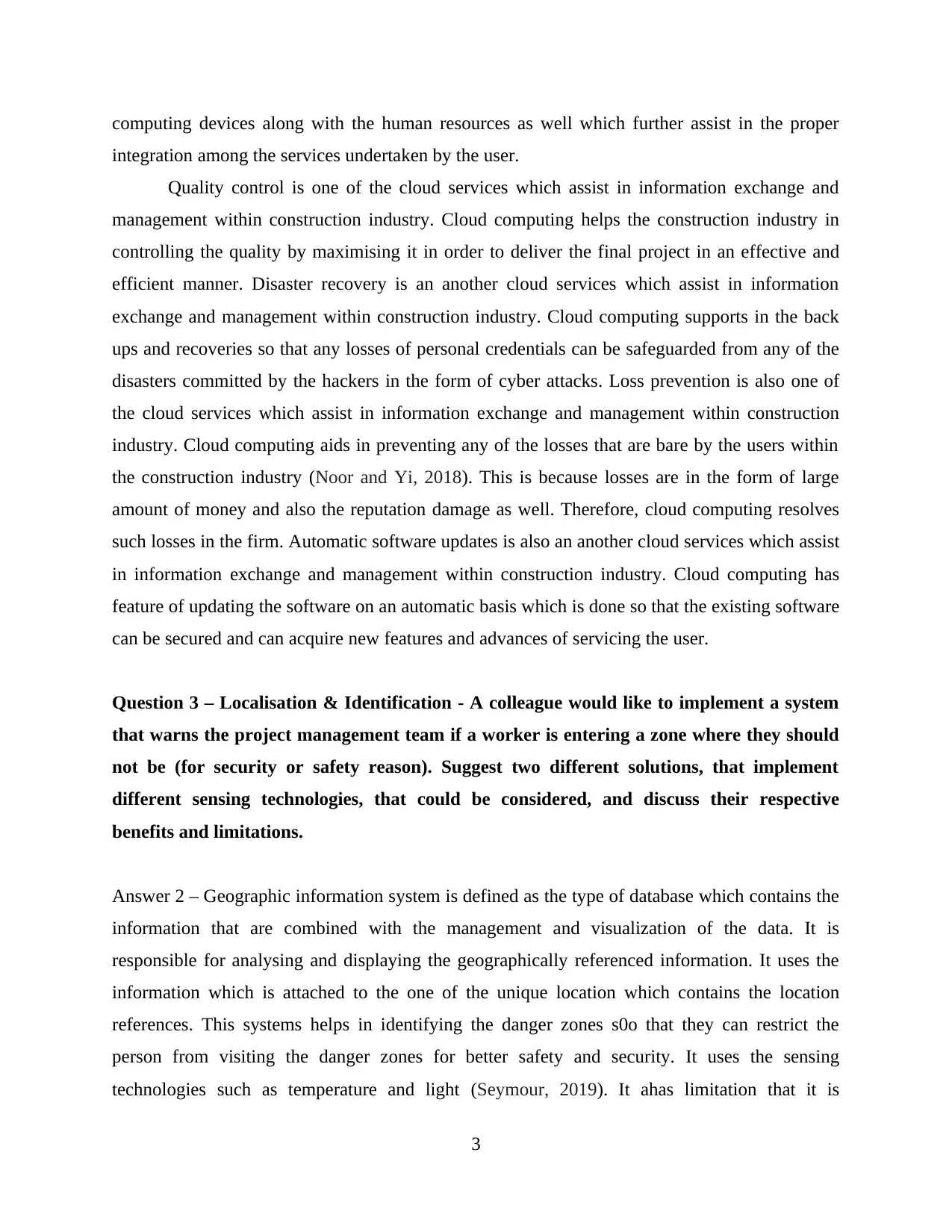
computing devices along with the human resources as well which further assist in the proper
integration among the services undertaken by the user.
Quality control is one of the cloud services which assist in information exchange and
management within construction industry. Cloud computing helps the construction industry in
controlling the quality by maximising it in order to deliver the final project in an effective and
efficient manner. Disaster recovery is an another cloud services which assist in information
exchange and management within construction industry. Cloud computing supports in the back
ups and recoveries so that any losses of personal credentials can be safeguarded from any of the
disasters committed by the hackers in the form of cyber attacks. Loss prevention is also one of
the cloud services which assist in information exchange and management within construction
industry. Cloud computing aids in preventing any of the losses that are bare by the users within
the construction industry (Noor and Yi, 2018). This is because losses are in the form of large
amount of money and also the reputation damage as well. Therefore, cloud computing resolves
such losses in the firm. Automatic software updates is also an another cloud services which assist
in information exchange and management within construction industry. Cloud computing has
feature of updating the software on an automatic basis which is done so that the existing software
can be secured and can acquire new features and advances of servicing the user.
Question 3 – Localisation & Identification - A colleague would like to implement a system
that warns the project management team if a worker is entering a zone where they should
not be (for security or safety reason). Suggest two different solutions, that implement
different sensing technologies, that could be considered, and discuss their respective
benefits and limitations.
Answer 2 – Geographic information system is defined as the type of database which contains the
information that are combined with the management and visualization of the data. It is
responsible for analysing and displaying the geographically referenced information. It uses the
information which is attached to the one of the unique location which contains the location
references. This systems helps in identifying the danger zones s0o that they can restrict the
person from visiting the danger zones for better safety and security. It uses the sensing
technologies such as temperature and light (Seymour, 2019). It ahas limitation that it is
3
integration among the services undertaken by the user.
Quality control is one of the cloud services which assist in information exchange and
management within construction industry. Cloud computing helps the construction industry in
controlling the quality by maximising it in order to deliver the final project in an effective and
efficient manner. Disaster recovery is an another cloud services which assist in information
exchange and management within construction industry. Cloud computing supports in the back
ups and recoveries so that any losses of personal credentials can be safeguarded from any of the
disasters committed by the hackers in the form of cyber attacks. Loss prevention is also one of
the cloud services which assist in information exchange and management within construction
industry. Cloud computing aids in preventing any of the losses that are bare by the users within
the construction industry (Noor and Yi, 2018). This is because losses are in the form of large
amount of money and also the reputation damage as well. Therefore, cloud computing resolves
such losses in the firm. Automatic software updates is also an another cloud services which assist
in information exchange and management within construction industry. Cloud computing has
feature of updating the software on an automatic basis which is done so that the existing software
can be secured and can acquire new features and advances of servicing the user.
Question 3 – Localisation & Identification - A colleague would like to implement a system
that warns the project management team if a worker is entering a zone where they should
not be (for security or safety reason). Suggest two different solutions, that implement
different sensing technologies, that could be considered, and discuss their respective
benefits and limitations.
Answer 2 – Geographic information system is defined as the type of database which contains the
information that are combined with the management and visualization of the data. It is
responsible for analysing and displaying the geographically referenced information. It uses the
information which is attached to the one of the unique location which contains the location
references. This systems helps in identifying the danger zones s0o that they can restrict the
person from visiting the danger zones for better safety and security. It uses the sensing
technologies such as temperature and light (Seymour, 2019). It ahas limitation that it is
3
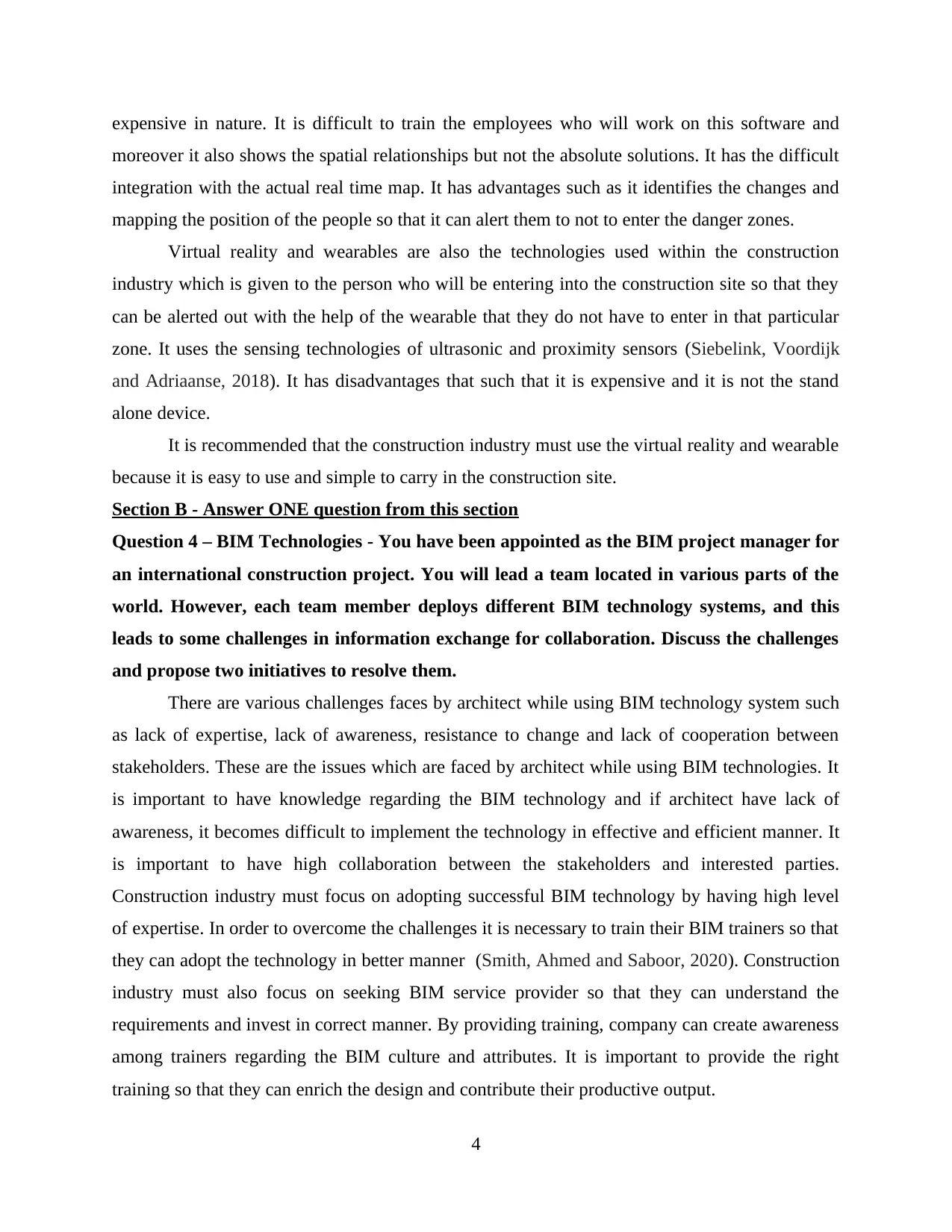
expensive in nature. It is difficult to train the employees who will work on this software and
moreover it also shows the spatial relationships but not the absolute solutions. It has the difficult
integration with the actual real time map. It has advantages such as it identifies the changes and
mapping the position of the people so that it can alert them to not to enter the danger zones.
Virtual reality and wearables are also the technologies used within the construction
industry which is given to the person who will be entering into the construction site so that they
can be alerted out with the help of the wearable that they do not have to enter in that particular
zone. It uses the sensing technologies of ultrasonic and proximity sensors (Siebelink, Voordijk
and Adriaanse, 2018). It has disadvantages that such that it is expensive and it is not the stand
alone device.
It is recommended that the construction industry must use the virtual reality and wearable
because it is easy to use and simple to carry in the construction site.
Section B - Answer ONE question from this section
Question 4 – BIM Technologies - You have been appointed as the BIM project manager for
an international construction project. You will lead a team located in various parts of the
world. However, each team member deploys different BIM technology systems, and this
leads to some challenges in information exchange for collaboration. Discuss the challenges
and propose two initiatives to resolve them.
There are various challenges faces by architect while using BIM technology system such
as lack of expertise, lack of awareness, resistance to change and lack of cooperation between
stakeholders. These are the issues which are faced by architect while using BIM technologies. It
is important to have knowledge regarding the BIM technology and if architect have lack of
awareness, it becomes difficult to implement the technology in effective and efficient manner. It
is important to have high collaboration between the stakeholders and interested parties.
Construction industry must focus on adopting successful BIM technology by having high level
of expertise. In order to overcome the challenges it is necessary to train their BIM trainers so that
they can adopt the technology in better manner (Smith, Ahmed and Saboor, 2020). Construction
industry must also focus on seeking BIM service provider so that they can understand the
requirements and invest in correct manner. By providing training, company can create awareness
among trainers regarding the BIM culture and attributes. It is important to provide the right
training so that they can enrich the design and contribute their productive output.
4
moreover it also shows the spatial relationships but not the absolute solutions. It has the difficult
integration with the actual real time map. It has advantages such as it identifies the changes and
mapping the position of the people so that it can alert them to not to enter the danger zones.
Virtual reality and wearables are also the technologies used within the construction
industry which is given to the person who will be entering into the construction site so that they
can be alerted out with the help of the wearable that they do not have to enter in that particular
zone. It uses the sensing technologies of ultrasonic and proximity sensors (Siebelink, Voordijk
and Adriaanse, 2018). It has disadvantages that such that it is expensive and it is not the stand
alone device.
It is recommended that the construction industry must use the virtual reality and wearable
because it is easy to use and simple to carry in the construction site.
Section B - Answer ONE question from this section
Question 4 – BIM Technologies - You have been appointed as the BIM project manager for
an international construction project. You will lead a team located in various parts of the
world. However, each team member deploys different BIM technology systems, and this
leads to some challenges in information exchange for collaboration. Discuss the challenges
and propose two initiatives to resolve them.
There are various challenges faces by architect while using BIM technology system such
as lack of expertise, lack of awareness, resistance to change and lack of cooperation between
stakeholders. These are the issues which are faced by architect while using BIM technologies. It
is important to have knowledge regarding the BIM technology and if architect have lack of
awareness, it becomes difficult to implement the technology in effective and efficient manner. It
is important to have high collaboration between the stakeholders and interested parties.
Construction industry must focus on adopting successful BIM technology by having high level
of expertise. In order to overcome the challenges it is necessary to train their BIM trainers so that
they can adopt the technology in better manner (Smith, Ahmed and Saboor, 2020). Construction
industry must also focus on seeking BIM service provider so that they can understand the
requirements and invest in correct manner. By providing training, company can create awareness
among trainers regarding the BIM culture and attributes. It is important to provide the right
training so that they can enrich the design and contribute their productive output.
4
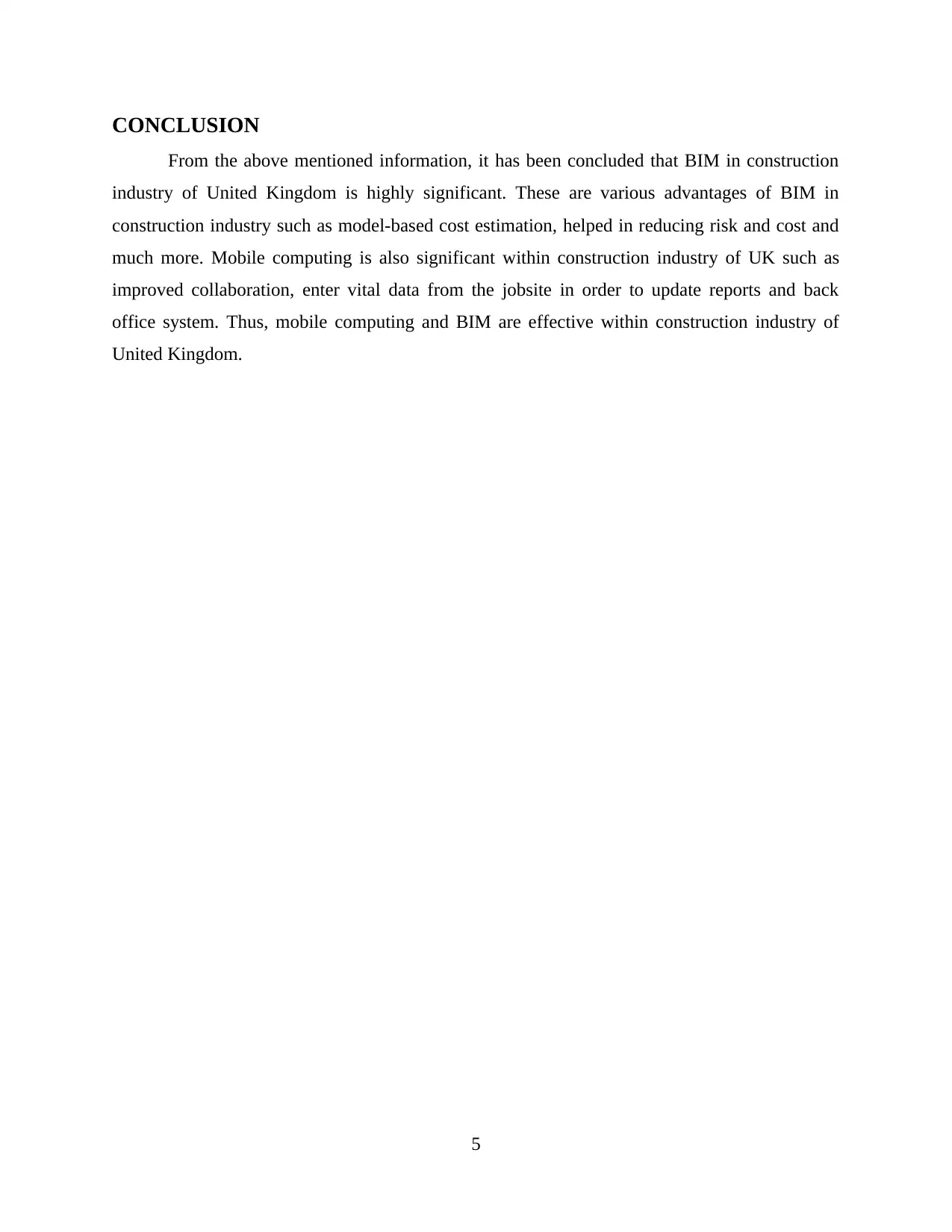
CONCLUSION
From the above mentioned information, it has been concluded that BIM in construction
industry of United Kingdom is highly significant. These are various advantages of BIM in
construction industry such as model-based cost estimation, helped in reducing risk and cost and
much more. Mobile computing is also significant within construction industry of UK such as
improved collaboration, enter vital data from the jobsite in order to update reports and back
office system. Thus, mobile computing and BIM are effective within construction industry of
United Kingdom.
5
From the above mentioned information, it has been concluded that BIM in construction
industry of United Kingdom is highly significant. These are various advantages of BIM in
construction industry such as model-based cost estimation, helped in reducing risk and cost and
much more. Mobile computing is also significant within construction industry of UK such as
improved collaboration, enter vital data from the jobsite in order to update reports and back
office system. Thus, mobile computing and BIM are effective within construction industry of
United Kingdom.
5
Paraphrase This Document
Need a fresh take? Get an instant paraphrase of this document with our AI Paraphraser
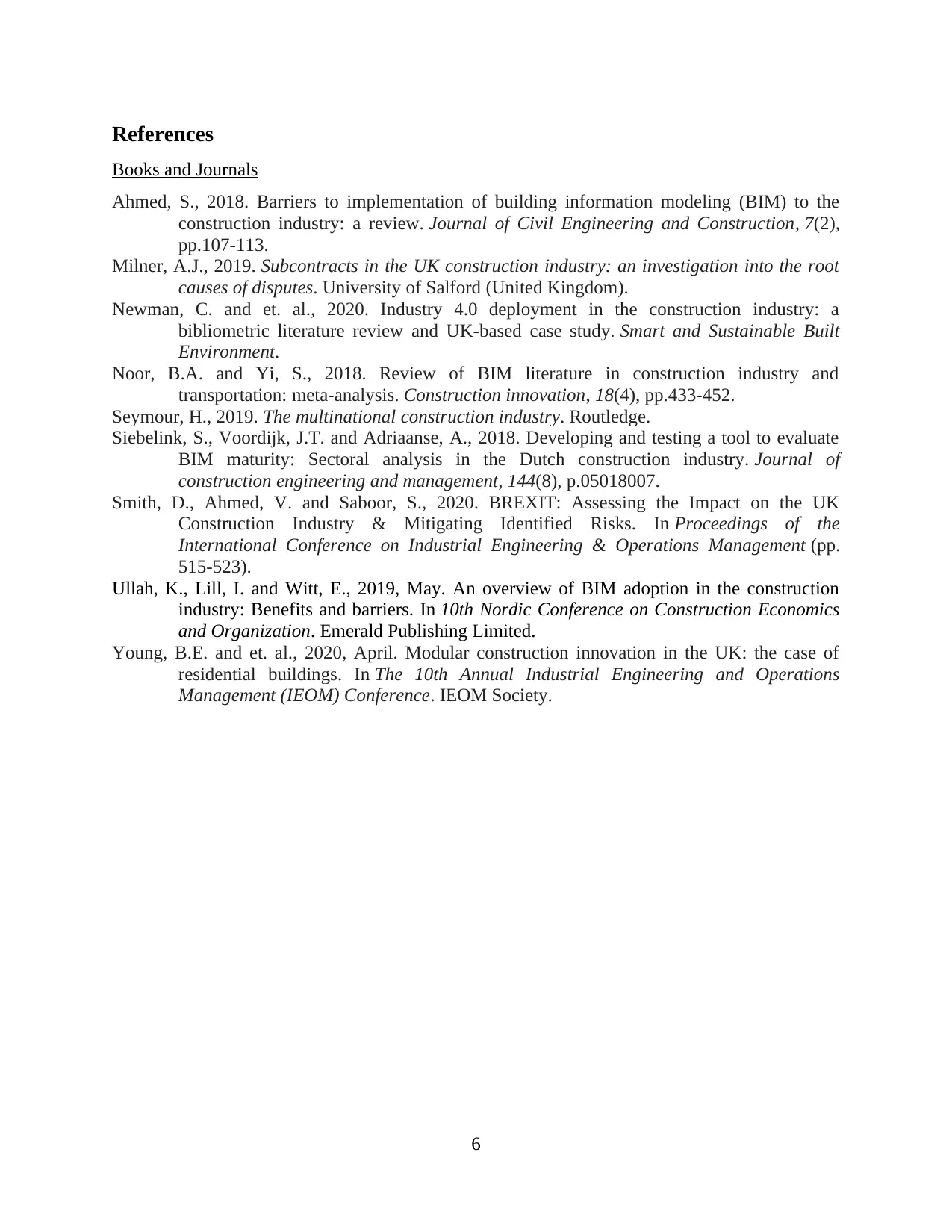
References
Books and Journals
Ahmed, S., 2018. Barriers to implementation of building information modeling (BIM) to the
construction industry: a review. Journal of Civil Engineering and Construction, 7(2),
pp.107-113.
Milner, A.J., 2019. Subcontracts in the UK construction industry: an investigation into the root
causes of disputes. University of Salford (United Kingdom).
Newman, C. and et. al., 2020. Industry 4.0 deployment in the construction industry: a
bibliometric literature review and UK-based case study. Smart and Sustainable Built
Environment.
Noor, B.A. and Yi, S., 2018. Review of BIM literature in construction industry and
transportation: meta-analysis. Construction innovation, 18(4), pp.433-452.
Seymour, H., 2019. The multinational construction industry. Routledge.
Siebelink, S., Voordijk, J.T. and Adriaanse, A., 2018. Developing and testing a tool to evaluate
BIM maturity: Sectoral analysis in the Dutch construction industry. Journal of
construction engineering and management, 144(8), p.05018007.
Smith, D., Ahmed, V. and Saboor, S., 2020. BREXIT: Assessing the Impact on the UK
Construction Industry & Mitigating Identified Risks. In Proceedings of the
International Conference on Industrial Engineering & Operations Management (pp.
515-523).
Ullah, K., Lill, I. and Witt, E., 2019, May. An overview of BIM adoption in the construction
industry: Benefits and barriers. In 10th Nordic Conference on Construction Economics
and Organization. Emerald Publishing Limited.
Young, B.E. and et. al., 2020, April. Modular construction innovation in the UK: the case of
residential buildings. In The 10th Annual Industrial Engineering and Operations
Management (IEOM) Conference. IEOM Society.
6
Books and Journals
Ahmed, S., 2018. Barriers to implementation of building information modeling (BIM) to the
construction industry: a review. Journal of Civil Engineering and Construction, 7(2),
pp.107-113.
Milner, A.J., 2019. Subcontracts in the UK construction industry: an investigation into the root
causes of disputes. University of Salford (United Kingdom).
Newman, C. and et. al., 2020. Industry 4.0 deployment in the construction industry: a
bibliometric literature review and UK-based case study. Smart and Sustainable Built
Environment.
Noor, B.A. and Yi, S., 2018. Review of BIM literature in construction industry and
transportation: meta-analysis. Construction innovation, 18(4), pp.433-452.
Seymour, H., 2019. The multinational construction industry. Routledge.
Siebelink, S., Voordijk, J.T. and Adriaanse, A., 2018. Developing and testing a tool to evaluate
BIM maturity: Sectoral analysis in the Dutch construction industry. Journal of
construction engineering and management, 144(8), p.05018007.
Smith, D., Ahmed, V. and Saboor, S., 2020. BREXIT: Assessing the Impact on the UK
Construction Industry & Mitigating Identified Risks. In Proceedings of the
International Conference on Industrial Engineering & Operations Management (pp.
515-523).
Ullah, K., Lill, I. and Witt, E., 2019, May. An overview of BIM adoption in the construction
industry: Benefits and barriers. In 10th Nordic Conference on Construction Economics
and Organization. Emerald Publishing Limited.
Young, B.E. and et. al., 2020, April. Modular construction innovation in the UK: the case of
residential buildings. In The 10th Annual Industrial Engineering and Operations
Management (IEOM) Conference. IEOM Society.
6
1 out of 8
Related Documents
Your All-in-One AI-Powered Toolkit for Academic Success.
+13062052269
info@desklib.com
Available 24*7 on WhatsApp / Email
![[object Object]](/_next/static/media/star-bottom.7253800d.svg)
Unlock your academic potential
© 2024 | Zucol Services PVT LTD | All rights reserved.





